
The Bush administration worked behind the scenes altering White House and G8 documents to downplay the impact of climate change. White House Council on Environmental Quality chief of staff Philip Cooney repeatedly edited government climate reports. He used to work for the American Petroleum Institute and now he’s left the White House to work for ExxonMobil. We speak to the New York Times reporter who broke the story. [includes rush transcript]
The Bush administration worked behind the scenes to weaken key language in the Group of 8 proposal for joint action on climate change. The Washington Post reported on Friday that administration officials successfully pressed negotiators to drop sections of the report that warned of more frequent droughts and floods and commited a specific dollar amount to promoting carbon sequestration in developing countries.
This follows major revelations published in the New York Times earlier this month that a White House official repeatedly edited government climate reports in ways that played down links between greenhouse gas emissions and global warming. The official —Philip Cooney— was chief of staff for the White House Council on Environmental Quality which shapes much of America”s environmental policy. Before coming to the White House in 2001, Cooney was a lobbyist at the American Petroleum Institute.
Just two days after that article was published, Cooney resigned from the council and ExxonMobil announced they were hiring him. A recent investigation by Mother Jones magazine found that ExxonMobil has spent at least eight million dollars funding a network of groups to challenge the existence of global warming.
ExxonMobile defended its hiring of Cooney by stating that they hire from both sides of the aisle. In a written statement to Democracy Now! The company wrote that “ExxonMobil hired Mr. Cooney at about the same time we hired Matt Gobush, who was the Communications Director for Democratic Senator Joe Lieberman. We have always hired highly qualified people for their talent—not their politics.”
- Andrew Revkin, prize-winning science reporter with The New York Times. He wrote the books “Global Warming: Understanding the Forecast” and “Burning Season: The Murder of Chico Mendes and the Fight for the Amazon Rain Forest.” He is the recipient of the National Academies Communication Award for print journalism, two Science Journalism Awards of the American Association for the Advancement of Science and an Investigative Reporters & Editors Awards.
-Read Revkin’s recent Arctic coverage
-Andrew Revkin also plays with Acoustic-Roots Band, Uncle Wade
Transcript
AMY GOODMAN: We are joined now by Andrew Revkin, The New York Times reporter who broke the story about Philip Cooney. Andrew Revkin is a prize-winning science writer at The New York Times and he wrote the book Global Warming: Understanding the Forecast and Burning Season: The Murder of Chico Mendes and the Fight for the Amazon Rainforest, recipient of the National Academy’s Communication Award for Print Journalism, two Science Journalism Awards of the American Association for the Advancement of Science, as well as an Investigative Reporters & Editors Award. Welcome to Democracy Now! It’s good to have you with us.
ANDREW REVKIN: Thank you, Amy.
AMY GOODMAN: So, let’s start off with the Philip Cooney saga. Tell us how significant it is that he ran the White House Council on Environmental Quality, where he came from and where he’s going.
ANDREW REVKIN: Well, Phil Cooney, who I have only met once, he’s kind of a background character, at least in terms of the White House public persona. He went there in 2001 and before that, for about a decade, he was a lawyer for the American Petroleum Institute, which is the leading lobby for the oil industry in Washington. And his last job there was — they called him climate team leader, and he was in charge, essentially, of an effort to both forestall any kind of international agreement limiting greenhouse gas emissions blamed for global warming and also domestic legislation and regulations. The E.P.A. was considering regulating CO2 coming from car exhausts, carbon dioxide being the main greenhouse gas, and he led the effort from the industry to stop all of that stuff. And then he went to the White House in 2001 and essentially, at least according to everything that I have seen, continued that same effort.
AMY GOODMAN: Talk about what he deleted, what he took out of the reports.
ANDREW REVKIN: It’s all — if you looked at individual wording changes and revisions and rewrites, you might say, oh, you know, what is that, it’s just a little qualifying adjective or, you know, what’s a big paragraph in a 300-page document, but when you look at the sum total of what changed, essentially scientists from a dozen agencies and other officials from a dozen agencies spent months on these reports coming up with language that they thought framed the issues correctly, as far as the science goes, so when they put in a line that said the earth is experiencing significant climate —- significant change, environmental change right now, they meant that. It’s a real thing. It’s pretty unassailable fact. And in that instance, he changed the word “is” to “may be”—- the earth “may be” undergoing a period of unusual environmental change. And that kind of thing, for scientists again is just sort of anathema, someone who had no scientific training, he has got an economics bachelors degree and a law degree and also with, essentially, a vested interest for years in not accepting the science on global warming. That he was doing that kind of revision was kind of horrifying to scientists within the government, and that’s why they came to me with the documents.
AMY GOODMAN: Yesterday John McCain, who’s basically announcing that he is running for president, was on Tim Russert’s “Meet the Press,” and Russert questioned him about your report on Philip Cooney.
TIM RUSSERT: Senator, let me show you a story from Wednesday’s New York Times. Philip A. Cooney, the former White House staff member who repeatedly revised government scientific reports on global warming will go to work for ExxonMobil this fall. Mr. Cooney resigned as Chief of Staff for President Bush’s Environmental Policy Council, two days after documents obtained by The New York Times revealed that he had edited the reports in ways that of cast doubt on the link between the emission of greenhouse gases and rising temperatures. What do you think of that?
JOHN McCAIN: I’m shocked, shocked that such a thing should be happening. I also noticed that he immediately went back to work with ExxonMobil. Maybe he should have waited a month or two.
AMY GOODMAN: John McCain on “Meet the Press” yesterday. You just interviewed John McCain. Your response, and also overall to what he is putting forward?
ANDREW REVKIN: Well, McCain and a few other Republicans of various degrees of moderacy have been trying to put distance between themselves and the White House. I think they see public opinion on this moving in a direction different from where the White House has put their policies so far. And so he has — despite embracing the Administration on many fronts, he seems to — he doesn’t want to be identified with them on this one. And he has this proposal that’s part of — could be part of the energy bill that would require cuts in greenhouse gases over — it’s a very gentle proposal; it’s nothing like the Kyoto Protocol, which was much more —- the slope of that was much more steep. And this would be really kind of a slow slide toward regulation. And -—
AMY GOODMAN: Also putting forward nuclear within that?
ANDREW REVKIN: Well, right, and then he — in order to broaden the base of support for the bill, he chose to add nuclear power, which actually has weakened his proposal now because a lot of the mainstream environmental groups just can’t go there, even though nuclear power for all of its warts and problems doesn’t emit carbon dioxide like coal-fired power plants or gas or oil do when they’re burned. So it’s clean to the extent that it doesn’t contribute to the climate problem. And so he’s — but he’s got this funny dance that he has to kind of make to find a common ground there. And I don’t know whether it’s possible, frankly.
AMY GOODMAN: On the issue of questioning global warming, on another of the talk shows yesterday “This Week with George Stephanopoulos,” George Will weighed in.
GEORGE WILL: They are almost as united today and almost as certain today that global warming is a threat, as 30 years ago they were that global cooling was a threat. We’ve got some excerpts from journalism back in those days. Thirty years ago, George, The New York Times was warning about the return to another ice age, that major cooling of the climate is widely considered inevitable. Science Magazine warned of extensive northern hemisphere glaciation — glaciers in northern Europe, there were going to be. Christian Science Monitor said again, “Glaciers have begun to advance,” and my favorite from International Wildlife, “A new ice age must now stand alongside nuclear war as a likely source of wholesale death and misery.”
AMY GOODMAN: Conservative columnist George Will on ABC’s “This Week with George Stephanopoulos.” Andrew Revkin, your response.
ANDREW REVKIN: Well, thirty years ago we were in a period of cool times. From the 1940s to the 1970s, what had been a pretty long, prolonged warming trend stopped for a while. And the growing scientific consensus on why that happened was because of another kind of pollution. In the big post-World War II industrial boom, we were putting up sooty stuff into the atmosphere that blocks sunlight and makes the earth cooler. And the modeling and observations now seem to confirm that essentially we were — the cooling input from human activities was overwhelming the warming input. And now, of course, since the 1990s there’s a warming trend that no one says is somehow natural, at least it’s not dominant — the natural influence is not dominant. It’s almost conclusive that it’s a human cause, warming now.
And as far as the ice age consensus back in the 1970s, some of that was driven — keep in mind that in the 1970s we didn’t even know that — we hadn’t confirmed that the continental drift was happening. Science has progressed a huge amount since the 1960s and 1970s, and the modeling, the computer power that’s been used to analysis what’s been happening with the atmosphere is just orders of magnitude beyond where it was then. And the scale, the time scale, you know, the return to an ice age would be centuries, millennia, and the warming that is predicted to be disruptive to ecosystems and human affairs is something we’re talking about within the next 100 years.
AMY GOODMAN: Speaking of cold, you have gone to the Arctic several times.
ANDREW REVKIN: Yes.
AMY GOODMAN: Can you talk about what you found there?
ANDREW REVKIN: Yeah. I have been — I’m going again this year, too. I’ve been to the North Pole, to the North Slope of Alaska and to Greenland over the last couple of years. And in all of those places, scientists have seen pretty powerful evidence of, as that climate report that the White House changed said, of significant environmental change right now. It’s still a complicated picture. The Arctic is a place we don’t have long term data on. So, you can’t immediately say that the trends that we have seen in the retreat of sea ice in the last three decades from satellites is unparalleled. The 1930s saw some warming in the Arctic. It wasn’t as uniform as what’s going on now, and in the past, of course, I wrote a story last fall, 50 million years ago there were ferns growing on the Arctic Ocean. It was 60-degree body of water, you could swim in it. And now it’s got ice on it.
So there’s all — on all scales there’s warming and cooling. But the pace of change in the last few decades is what has people really alarmed. On the North Slope, it’s actually woken up the oil companies there for the first time. The oil industry, when I reported a story a year or so ago from the North Slope, the frozen season, when they can explore for oil has shrunk by half in just 30 years. It used to be 200 days a year that the Arctic slope tundra was hard enough to drive a truck over, and now it’s 100 days. And so they pushed Alaska to start a new study to look at the rules and what’s going on up there. So it might that the Arctic warming is the first instance where we have seen a lot of concern from the oil companies about the implications of warming.
AMY GOODMAN: And yet you have them pouring money in, like, ExxonMobil to discount global warming, to raise questions about whether it’s even a problem.
ANDREW REVKIN: Some would call that a paradox.
AMY GOODMAN: Before we end, I wanted to talk about your book, The Burning Season: The Murder of Chico Mendes and the Fight for the Amazon Rainforest. You actually wrote it 15 years ago, but it’s just been reissued in paperback. Can you talk about who Chico Mendes was, and how he relates to this whole story of global warming?
ANDREW REVKIN: Sure. Well, there are two things. The Amazon itself only became a big news story because in the late 80s it was linked in our consciousness to global warming. The forests were burning. Our satellites showed thousands of fires in the Amazon at the same time. And Chico came out of the forest around that same time in 1987. He was kind of the ultimate pragmatic grassroots organizer. He tried communism once, and that didn’t work. He tried politics and he was a terrible politician. He was a home-grown rubber tree tapper from the Amazon who saw the forest falling because roads were being built, bringing ranching and other activities into the Amazon.
And he didn’t just sort of lie down in front of the bulldozers. He came to Washington and followed the money, which is a — he essentially wrote the book for how to get results. Even if you have a small, local issue like that you find where is the money coming from, what is the force that’s actually changing my life here. And for the rubber tappers it was money partially flowing from the Inter-American Development Bank, the big international lending institutions, and he went to senators, Senator Kasten from Wisconsin, and said, “Look, you know, why are you helping support this activity? They’re not paying attention to the people living in the forest.” And he got progress. Brazil created the first extractive reserves and areas where you could harvest from the forest without knocking it down. And then, of course, he paid the ultimate price because some ranchers commissioned his murder.
And it’s become relevant again in a few ways. Partially the Amazon is burning again at the rates it was back then in the late 80s. And that contributes hugely to the climate issue, the climate problem.
AMY GOODMAN: What do you mean burning?
ANDREW REVKIN: The forest — the rate of destruction of the forest there is greater than ever. And when you — to clear the Amazon, you burn it. You cut and burn, that’s basically how you clear. The burning season happens every fall, sort of the end of the dry season. And any time you burn fuel or wood, you’re adding carbon dioxide to the air. And that carbon dioxide lasts 100 years once it’s up there.
AMY GOODMAN: And the significance of the rain forest in Brazil for the globe?
ANDREW REVKIN: Well, it’s a reservoir of carbon, the stuff that when we liberate it by burning it, adds to the climate issue. And, of course, it’s also a reservoir of biological richness that’s relatively unparalleled. There’s only a few places on earth with the amount of species of plants and animals that the Amazon has. And it’s kind of a giant sponge. Twenty percent of the earth’s fresh water at any one time is in the Amazon. It’s an amazing, unique resource for everyone.
AMY GOODMAN: This past year the American nun Dorothy Stang was killed. Can you connect her back to Chico Mendes?
ANDREW REVKIN: Yes. Sister Dorothy was one of many American nuns who have worked over there, down there, for the last thirty or forty years. I got to know some others who worked directly with Chico. They were all fighting the same fight, which was basically for people who had been pushed off of other land by the rich Brazil and found no place to go, and were eking out a living, in some cases like Chico as rubber tapping and other cases like the area in Para, where she was working, it was farmers. But they were all facing the same thing. There the farmers in the Xingu area of the Amazon were trying to find a way to do forestry and farming together so they wouldn’t ruin the forest. And then large scale timber extraction and ranching efforts were pushing in, and she got in their way just like Chico got in their way in 1988.
AMY GOODMAN: Chico Mendes bringing together the labor movement and environmental movement, do he think that’s finally what did him in?
ANDREW REVKIN: Well, he — yeah. Efficacy is what did him in. And the efficacy came in part by linking things. He was sort of into globalization — he invented kind of a reverse form of globalization where you — before the Internet or anything, he uplinked his little home-grown movement to international environmental groups. He meshed labor and environmental issues and got some results.
AMY GOODMAN: And deeply believed in nonviolence.
ANDREW REVKIN: Absolutely.
AMY GOODMAN: Well, Andrew Revkin, I want to thank you for being with us, author of The Burning Season: The Murder of Chico Mendes and the Fight for the Amazon Rainforest, also New York Times science reporter.

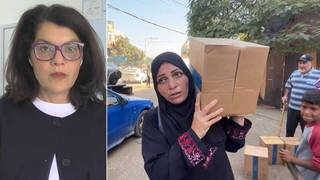
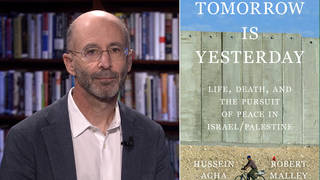
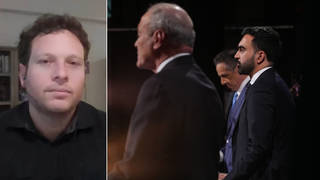
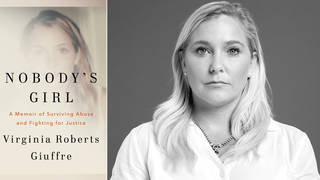





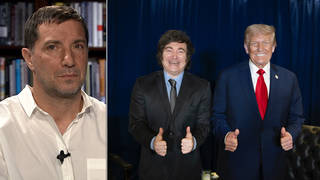
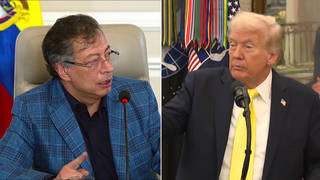
Media Options